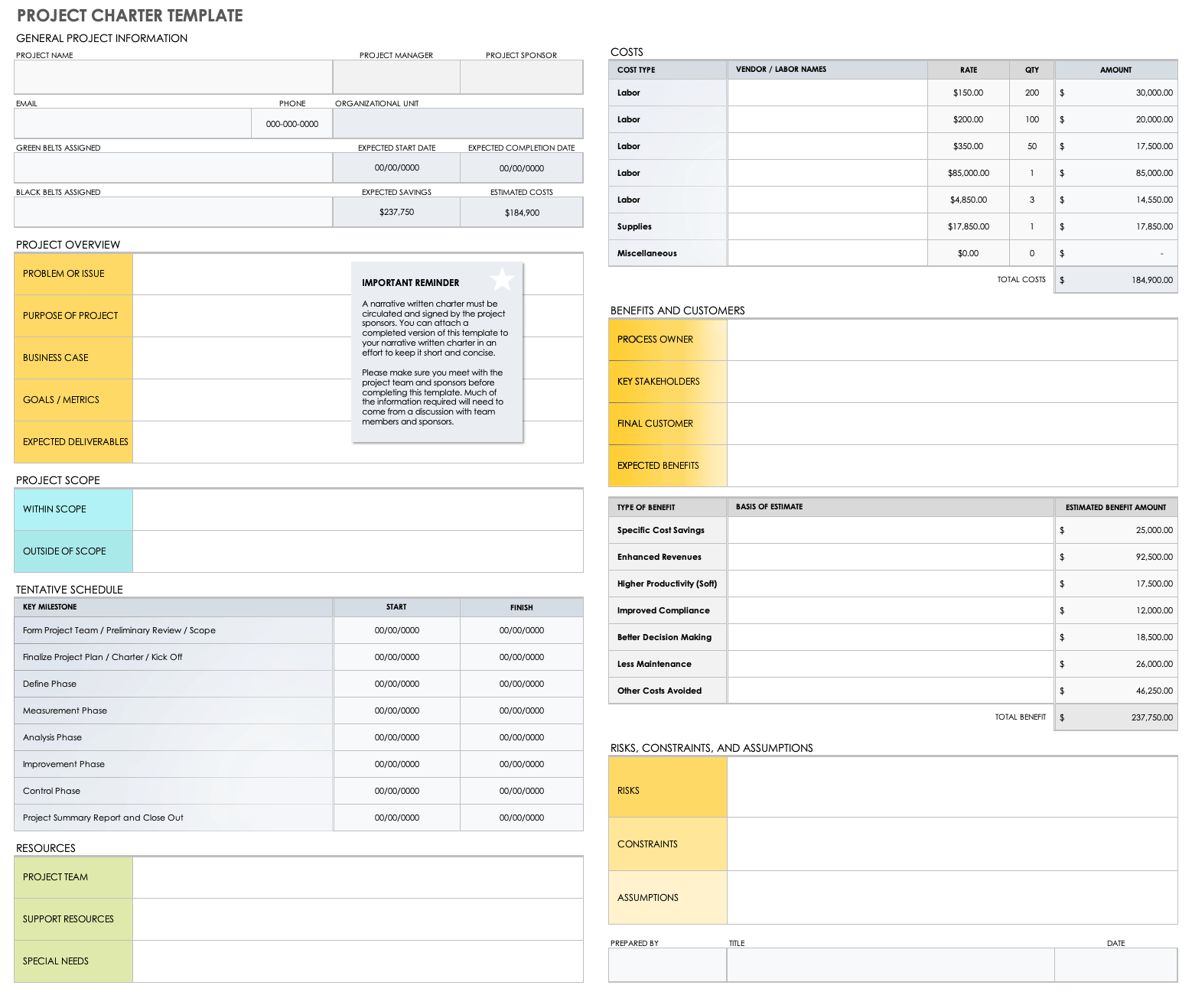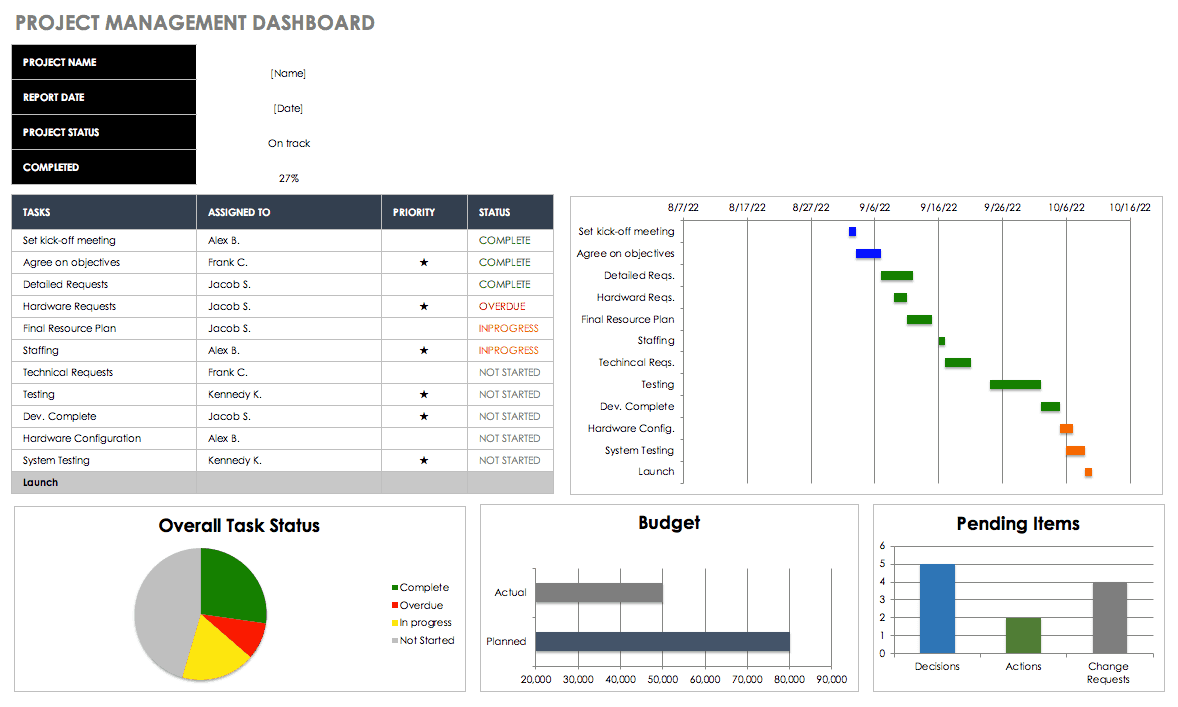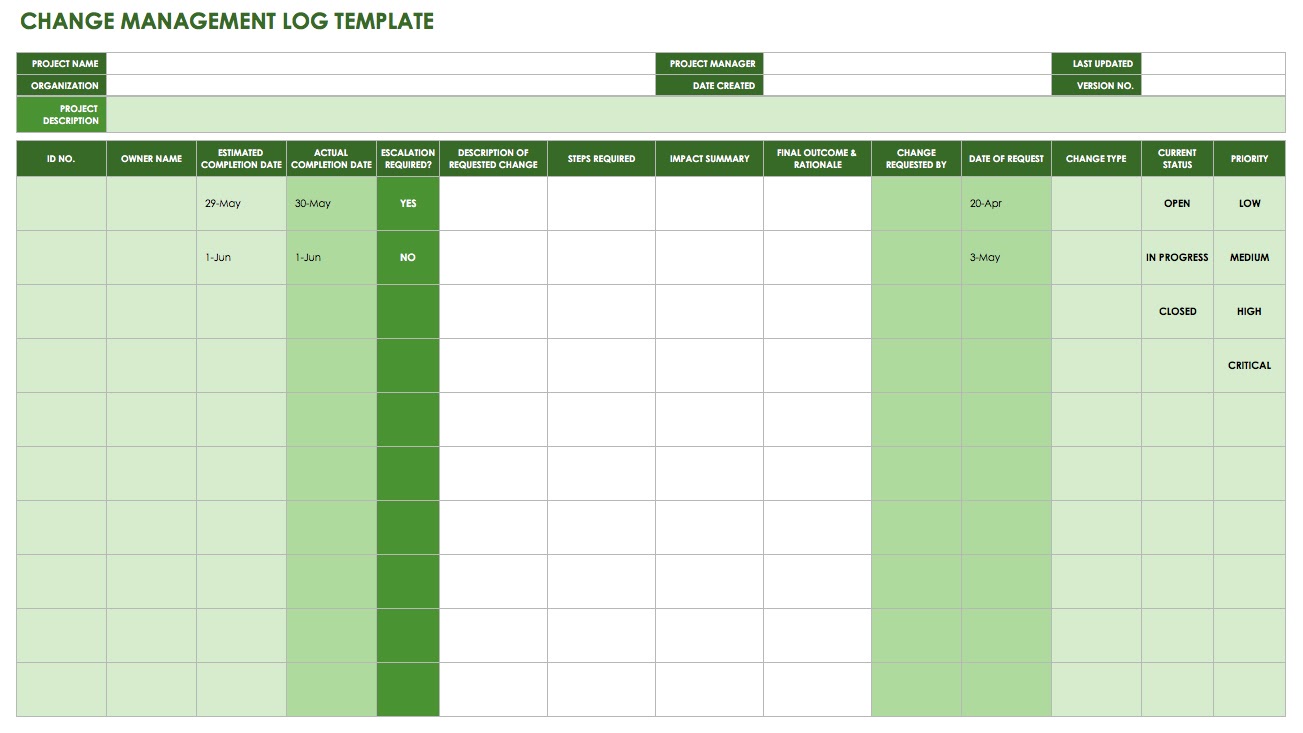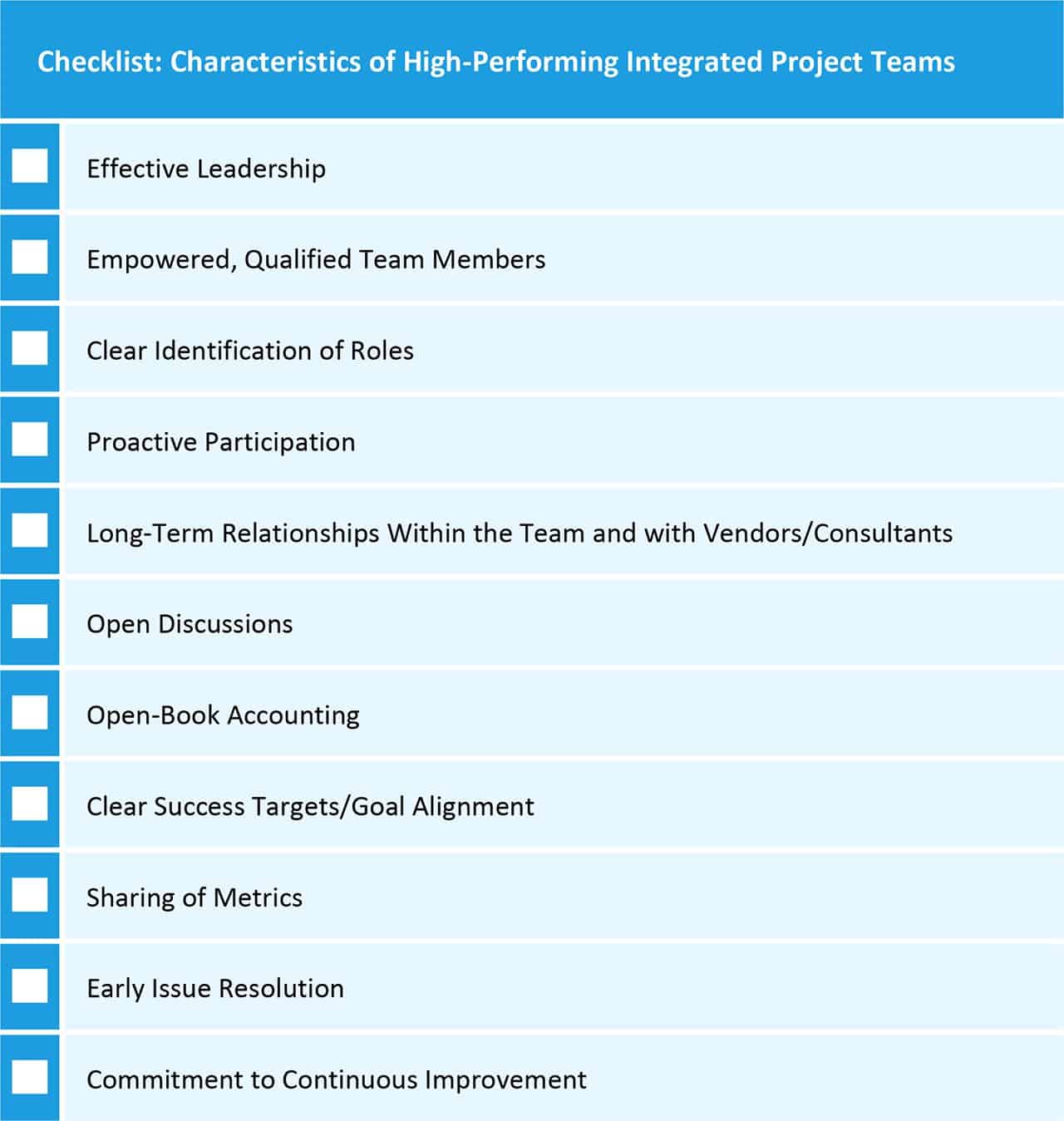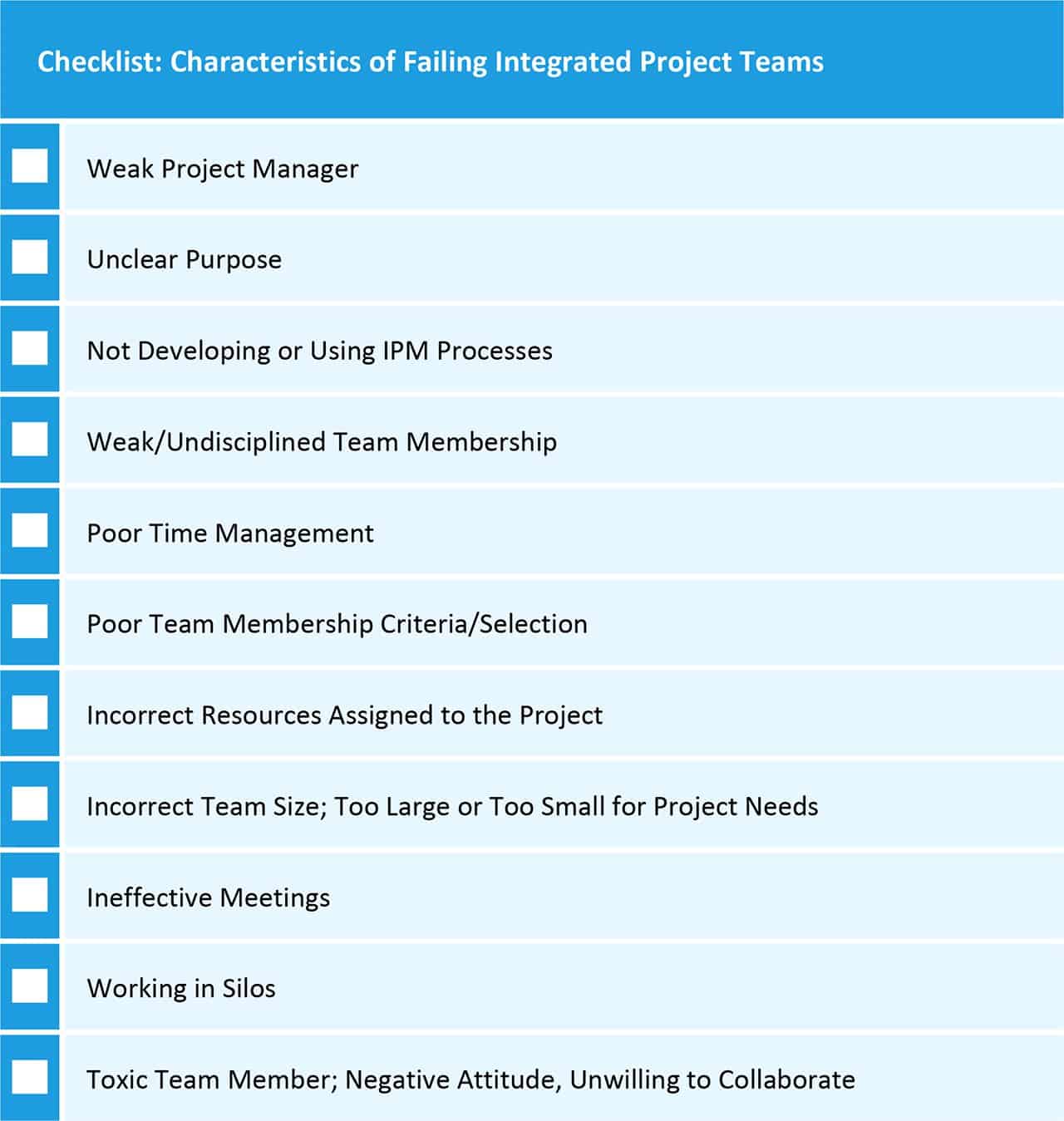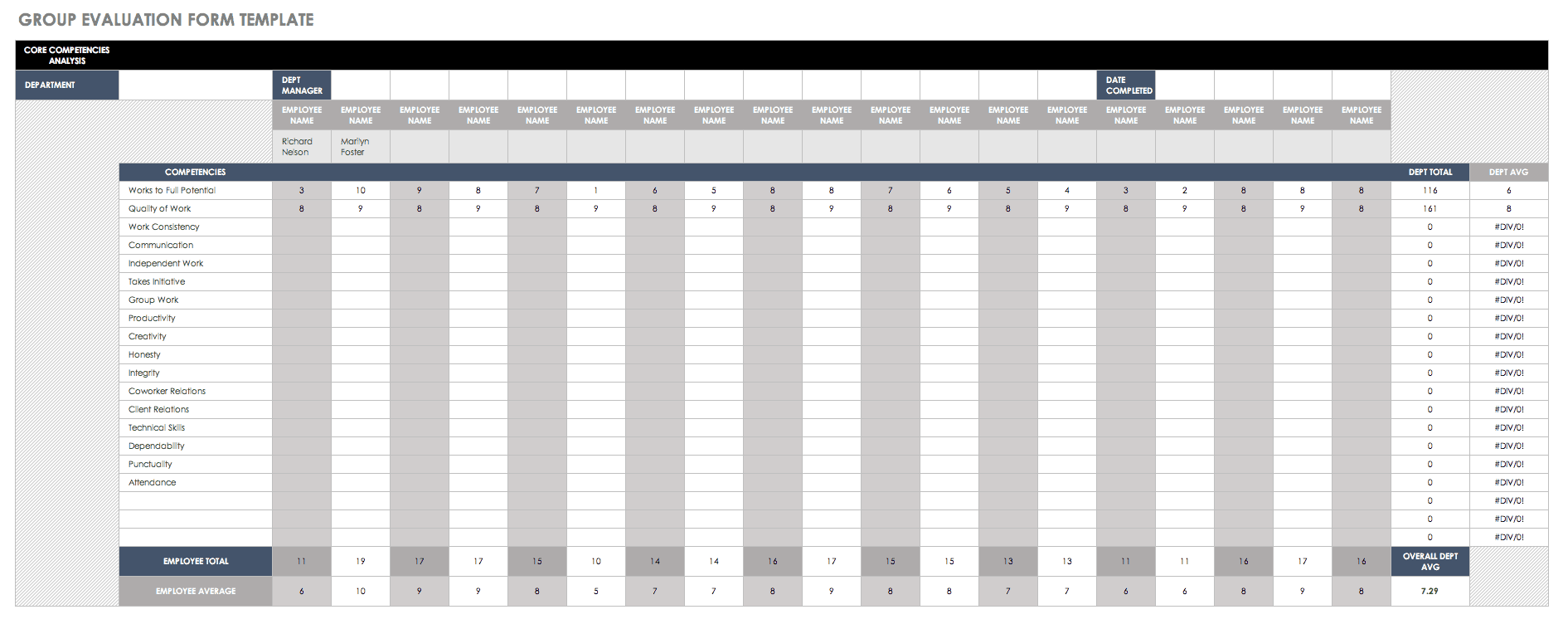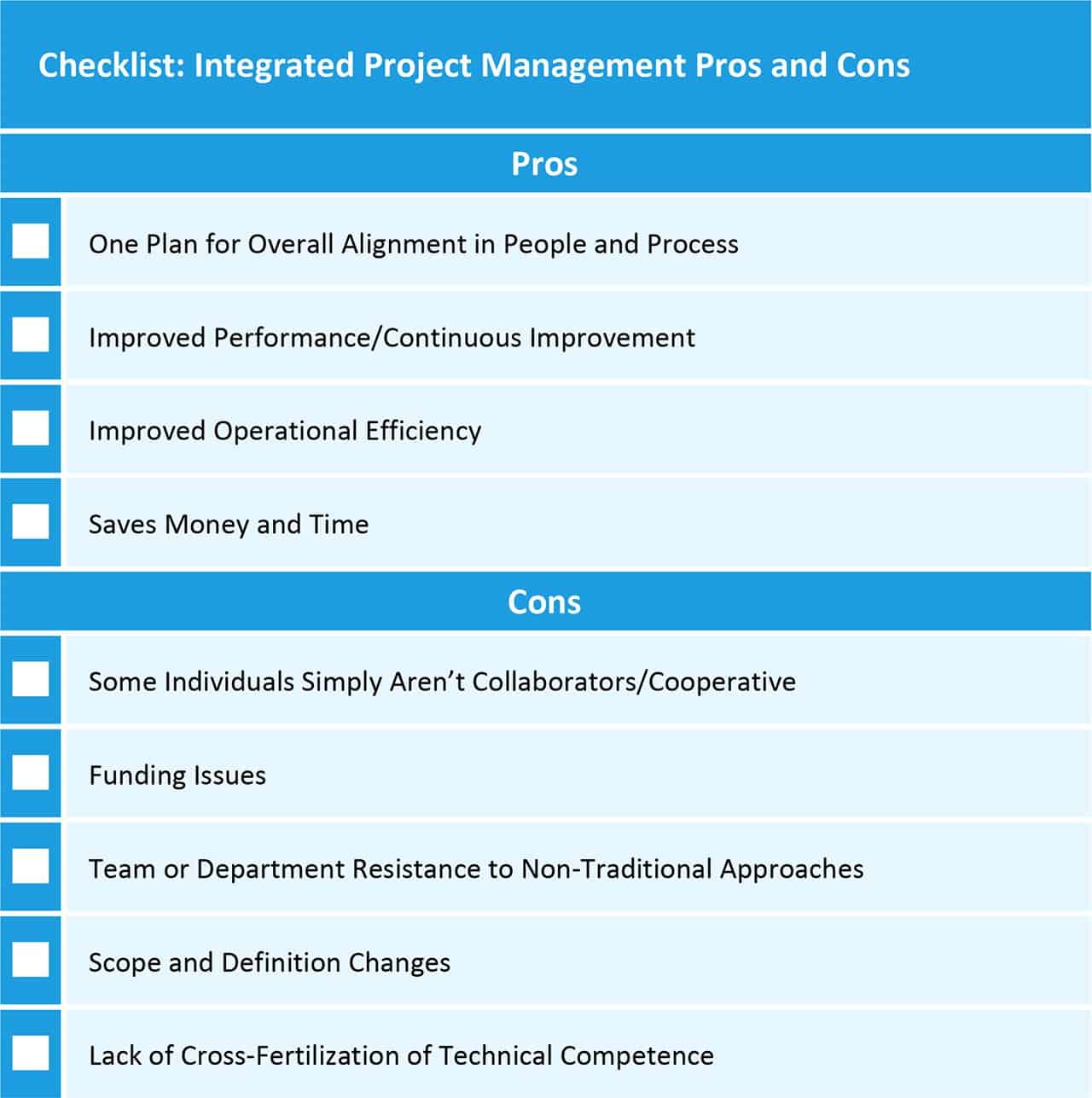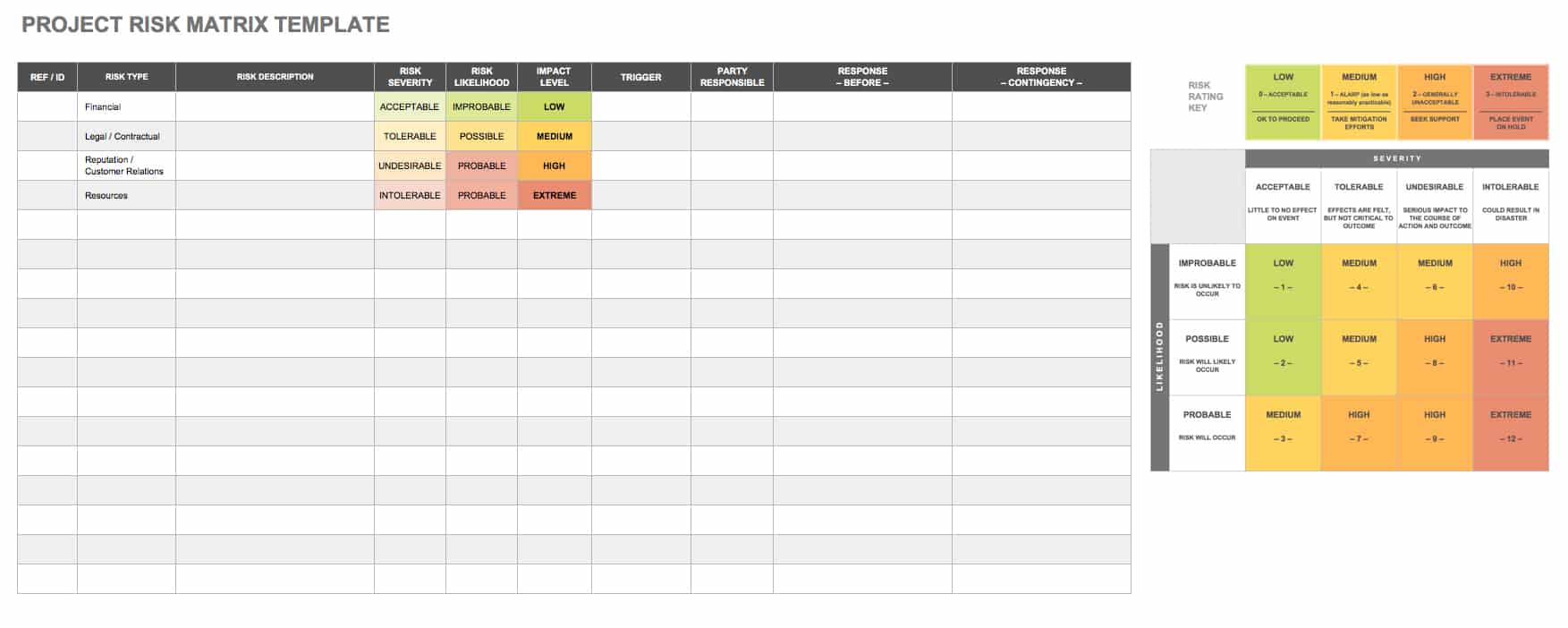What Is an Integrated Project?
Let’s open this toolkit by clarifying terms. First, let’s define integrated projects. An integrated project is a collaborative enterprise that requires different individuals or departments with varying skill sets to work together and achieve a stated goal to build a structure, product, or service. The methodology applies to many business sectors.
Project Management Guide
Your one-stop shop for everything project management

Ready to get more out of your project management efforts? Visit our comprehensive project management guide for tips, best practices, and free resources to manage your work more effectively.
What Is Integrated Project Delivery?
Integrated project delivery (IPD) is a Lean approach, most commonly associated with large-scale building and construction projects. IPD aligns the interests of stakeholders and team members, and integrates their work for optimal project performance using a collaborative, value-based process to increase high-outcome results for every team member and the project itself.
A primary objective of IPD is to work through potential issues in early project phases, eliminating possible waste and risk through all stages of design, fabrication, and construction. Adopted as a best practice by the American Institute of Architects (AIA) and Associated General Contractors (AGC), IPD uses multi-party contracts between the owner, designer, and contractor as an essential characteristic that spreads risk to all major stakeholders.
To learn more about the IPD experience: read Create a Lean, Construction Building Machine with Integrated Project Management.
What Is Integrated Project Management?
Integrated project management, also known as collaborative working, is the use of processes that spur the effective selection, coordination, and synchronization of efforts to ensure that the agency or company optimizes the critical factors for success. Integrated project managers look at the big picture and the details of each project at the same time for maximum business value.
Integrated project management has multiple benefits. First, it helps control complex projects that are difficult to size and identify specifications, with hard-to-pinpoint aims. Second, it’s useful for disseminating knowledge. Far too often, project management knowledge is siloed in individual departments. IPM is a methodology to understand, collect, share, and implement project management knowledge and best practices across the organization and prevent the proliferation of multiple plans and timeframes across departments.
Learn more about project coordination and its value in How to Succeed in Project Integration Management.
How Is Integrated Project Management Different from Integrated Product Development?
Project management and product development, along with their integrated forms, are complementary but distinct. Both integrated project management and integrated product development use the skills and talents of multidisciplinary teams.
Projects are temporary and are undertaken to create a particular product or service, with a precise definition of deliverables and the dates they must be delivered. Products are offered to satisfy a need or want, or to solve problems in the marketplace. Products have multiple-stage life cycles, spanning development, introduction, management, and eventual retirement when the desire or need for it has diminished. Products are developed in a project context, and more than one project can be undertaken within a product life cycle.
Efficiency is the goal of new product development (NPD). Products and services need to be delivered at high quality and lower cost than those offered by competitors. Companies must also continuously provide innovative products and services at the same time. By integrating project and product management efforts, the risk is lowered, while creativity, knowledge sharing, and efficiency are increased.
For an in-depth look into IPD, read The Definitive Guide to Integrated Product Teams and Integrated Product Development.
Integrated Project Management (IPM) Standards
The development of a business app, an improved mobile phone infrastructure, or a national political campaign — they’re all projects. And they all need to be expertly managed to deliver results on time and on budget.
Staying on Track with Key Performance Indicators (KPIs)
Keeping an eye on performance metrics is fundamental to monitor progress to goals and is integral to every large-scale IPM process. KPIs provide an efficient way to look into how your IPM is progressing based on performance measurements set at the beginning of the project scope stage of the process. By using dashboards, team leaders and members have a visual snapshot of where they are, related historical trends, and the enablement of better, more informed decisions with real impact.
Maintaining vigilance in the multi-million-dollar building projects Roberts manages is a significant part of the job. “We monitor key project delivery milestones or stage gates continuously,” says Roberts. “We make inspections, check and make adjustments, and act immediately to correct issues based on KPIs.”
Learn about KPIs and access free templates in this All About KPI Dashboards article.
The Seven Steps of Integrated Project Management
The Project Management Institute (PMI) identifies IPM as one of 10 project management knowledge groups. As part of the Project Management Body of Knowledge (PMBOK), the book defines the acknowledged standards. For either the novice or the experienced project manager, the steps in IPM provide a road map to success.
“For IPM,” says Wakeman, “the stages are project charter, project scope, project management plan, project execution, project monitoring, and change control.” All of our experts acknowledged that while the framework standards are superior guidelines, every project is different and may call for tweaks to meet specific circumstances, team skill sets, and financial constraints.
The chart clarifies the steps in the IPM process, and the free templates that follow will make it easier to implement the steps with your team:
1. Develop Project Charter: As the foundational document to building a strong IPM team, the project charter spells out and describes your project. Working from the project charter, the project manager will have the authority to assign organizational resources to project activities, but the PM can’t be identified and assigned until the charter is in place.
Project Charter Template
Greenlighting a new project is simplified with a formal project charter. A project charter template outlines the project and includes key participants, scope, objectives, and overall goals. Usually, a project charter is a brief one to two pages, but it can be longer depending on the size, type, and complexity of the project.
2. Develop Preliminary Scope Statement: The project scope statement defines what needs to be accomplished during the course of the project and at its completion.The scope document covers objectives for the project, deliverables, acceptance criteria, and major milestones. The scope may change over the life of the project, but requires the approval of the sponsor and project manager.
Project Scope Template
This statement of work outline is ready to use in a Word format. The framework can be used as is or as a guide for creating a customized document. Areas covered include an introduction, scope of work, tasks, schedules, and financial information. Tables are pre-formatted for ease of use and also feature details you’d like to highlight.
Download Statement of Work Outline Template
3. Develop Project Management Plan: The project management plan is the primary tool for effective project coordination and holds budgets, real costs, schedules, human resources, and capital assets. Sub plans to track achievements along the way are integrated through the use of a work breakdown structure (WBS), which is defined by PMI as “a deliverable-oriented hierarchical decomposition of the work to be executed by the project team to accomplish the project objectives and create the required deliverables. It organizes and defines the total scope of the project. Each descending level represents an increasingly detailed definition of the project work. The WBS is decomposed into work packages. The deliverable orientation of the hierarchy includes both internal and external deliverables.”
Integrated Project Plan Template
This IPM project plan template can take many forms: You can choose to include a dynamic Gantt chart or a static timeline, and focus on action items along with overriding business goals. This type of template is well-suited to holding the full content of the WBS.
Download the Integrated Project Plan Template - Excel
4. Direct and Manage Project: This stage is centered on all the activities that align with the project's primary objectives and milestones described in the project plan. Measurement of speed and performance becomes vital in project execution.
5. Monitor and Control Project Work: In this phase, project performance data is collected based on what was set in the plan, and the information is shared with the team. If there are variances, you can assess trends, look at alternatives, and make any needed recommendations to get back on track.
Project Monitoring Dashboard
Gather reporting in an all-up dashboard to improve efficiency and make comparisons against your project plan. With this project management dashboard, communicate project status, and share both the big-picture view and areas where corrective action may need to be taken. Use this project management dashboard to share high-level status and details with stakeholders and team members.
Download Excel Project Management Dashboard - Excel
6. Perform Integrated Change Control: Even the most tightly planned project is subject to change. There are many reasons for deviations: circumstances and requirements shift as the project progresses, resources become unavailable, teams lag in delivery, or stakeholders ask for alterations well into the life of the project. Resistance and conflicting interests are common in projects with many moving parts. When you’re making trade-offs, a central document that tracks change requests is very useful.
Change Control Log Template
A change control or change management log can help you track the who, what, why, and when of change requests, along with current status, priority ranking, and how the issue was resolved, and can also be used for future reference. In addition, the template can be modified to include more detail if needed.
Download Change Management Log Template
7. Close Project or Phase: The close project phase is when you perform a controlled shutdown to conclude the project. At this stage, documents are archived, information is captured to preserve lessons learned, contracts are shut down if needed, and process assets are updated.
Wakeman thinks that the close project phase can be one of the most significant stages of IPM. “The formalized closing process allows an organization and their teams to capture best practices and lessons learned in a formalized manner. While most organizations may or may not do it, even with prompting, having it as a formal part of the framework is important to encourage compliance with this knowledge capture.”
The Role of the Project Management Office (PMO)
A project management office is the nerve center of successful integrated project management at any organization that handles complex projects. The PMO provides decision support information, although it usually isn’t a decision-making body. A PMO is the conduit for project delivery mechanisms and ensures that change is managed in a controlled way. PMOs generate and safeguard project documentation, report progress to executives and shareholders, track metrics and best practices, and sometimes provide training. PMOs help prioritize projects and ensure that project activities support the objectives of the organization.
Project Portfolio Management and Integrated Project Management
In integrated project management, the best practice is to shift the management of projects from individual silos to project portfolio management (PPM) managed by the PMO and its project managers. PPM methodology supports the analysis and collective management of current or proposed projects, with communication and transparency as a critical concept and pillar. By using a central system, managers and teams share, retain, and disseminate knowledge throughout the organization and inform future projects for continuous improvement.
Looking to strengthen your PMO? Check out the e-book Effective PMO Efforts: Challenging the Status Quo.
Integrated Project Management Use Cases
IPM is used in every type of complex project in every sector, private and public, including post-merger integrations, the oil and gas industry, healthcare, software development, and more.
“We use IPM (actually IPD) in construction projects: new construction, remodels, and tenant improvements,” says Roberts. “We also use the approach for infrastructure projects from structuring cabling, wireless installations, and security projects. It runs the full gamut.”
For Roberts, the upfront work of the IPM process is what makes it so relevant and useful. “The value comes when you evaluate the project early with the team to explore the idea, flesh out the details, define the strategy, and then allow strategy to drive delivering the project right. Exploring early reduces waste, redesign, and rework, which cost money and encourage delays.”
The Difference Between Government and Private Sector Integrated Project Management
Government entities from the municipal to federal levels widely use integrated project management, although in a different way than private sector organizations, both in terminology and process architecture. For example, within the Department of Defence (DOD), the integrated master plan (IMP) is the collection of milestones, called ‘events,’ that form an IPM program, and the scheduling that comes from IMP is the integrated master schedule (IMS), the key document in material purchases. In projects for the US Navy, the schedule is the integrated government schedule (IGS).
Beyond terminology, there are differences in the way IPM impacts government agencies versus private companies. Although IPM began as a government-developed process, some say there may be a difference in effectiveness between the different sectors. Without a profit motive, sometimes it is more difficult to enforce waste reduction or budget constraint. Silos and politics tend to be entrenched, so getting units to work cross-functionally can be more challenging. Also, tenured positions mean that there may be a resistance to change — or a lack of incentive. However, project managers who are politically savvy, motivated, and supported by leadership can make a difference despite the challenges.
Use Cases
Our contributing experts described use cases they’ve been involved with, from IT to the Times Square New Year’s Eve ball drop:
- IPM and Network Security: Even the largest corporations in the world run up against roadblocks and challenges. IPM is ideally suited to plan major initiatives and predict risk.
Roberts says, “I was part of a review committee of a cross-functional team approach that Cisco Systems used in both hardware and software-based solutions to network security issues that offers some interesting information about how to deal with complexity in an important area.” Cisco needed to deliver scalable and innovative security across multiple teams innovatively while lowering risk.
- IPM and Software Implementation: The identification of the project stages shouldn’t change between a small project and a more extensive or more complex, integrated one - IPM is scalable.
“What changes is how the work packages (the lowest level of project planning, control, and reporting) for each stage is addressed, who needs to have input, and the level of detail required from the output,” says Albright. “I’m currently participating in a moderately complex software implementation project for a larger municipality.”
Albright is assuming a dual role: both as a contributing project manager for the software implementation and lead PM for the implementation effort, which includes several work packages being delivered by other project teams.
“Regardless of the role, the project will follow the same stages,” says Albright, “although the deliverables in these stages will be considerably different. As the lead project manager for my company’s work package, I need to collaborate with our subcontractor’s PM to define the project charter for their work package as well as coordinate with the subject matter experts (SMEs) on my own team to complete the required planning for our work package. As the contributing PM for the larger project, I’m responsible for participating in the planning and initiation, execution, monitoring and controlling, and project closure of the parent project as it applies to my scope of supply.”
- IPM and Aircraft Manufacturing: Albright worked for an aircraft manufacturer to provide material characterization for a new commercial aircraft, which highlights the importance of planning and transparency in the IPM process:
“During the initiation phase of the project I was responsible for (a sub-project from the perspective of the integrated project team), I spent weeks working with my company’s resources to develop a plan to execute the required testing and evaluation of the materials being considered for building the aircraft. After the fully vetted plan had been pulled together, I gathered our management team for a kickoff meeting with the lead project manager, the buyer, and the core team of technical SMEs for the parent project.
“Within minutes of starting the schedule review, it became clear to the entire group that the execution of our work package was going to exceed the planned timeframe for the task within the integrated project plan (information I had not been provided in the documentation for the work package). The lead PM had neglected to detail the expectations of the parent project in the work package documentation, and moreover hadn’t shared them with anyone on our team, which meant we needed to re-evaluate the entire plan for execution. This resulted in several weeks of in-depth meetings as our team was bought up to speed with the integrated project objectives and we redeveloped our schedule for the deliverables.
“All these issues could have been avoided had a more detailed project charter been developed and made available to the contributing project manager (me).”
- IPM and the Times Square Ball Drop: Wakeman uses IPM for many kinds of projects, including one experienced by millions of people: the Times Square New Year’s Eve ball drop. The ball drop isn’t simply an event viewed from afar — there are people on the ground who pay for special access. On average, 90,000 spectators are in attendance, with millions watching on networks and cable channels.
- “I've seen IPM used effectively many times in working in Times Square on the ball dropping to ring in the New Year. This project is interesting because it requires the coordination of so many different teams, agencies, and moving parts. You aren't just throwing a party: You’re managing the logistics of several government agencies that need to work together to move people efficiently from point to point. You are managing the production of a made-for-television event that has viewership from around the world. You are managing millions of people who can turn out in the immediate area and need to be moved efficiently. Something like the ball drop doesn't happen on a soundstage or a contained area, so it’s a requirement to have strong project processes in place.”
The Integrated Project Team (IPT)
A group with diverse skill sets, the integrated project team (IPT) works together to deliver complex IPM projects. The team can be collocated or work from remote locations using virtual collaboration.
Origin of Integrated Project Teams
IPTs emerged in the DOD in the 1980s to support simultaneous engineering approaches and came to a head in 1995 when the Secretary of Defense directed the DOD to apply integrated product and process development (IPPD) and use IPTs throughout the acquisition process. Since that time, IPTs have been a part of project management in complex endeavors in the public and private sectors.
Characteristics of High-Performing Integrated Project Teams
Care needs to be taken in the way IPT members are selected because of the challenging dynamics when diverse individuals must work together closely and the need to build consensus is crucial.
“The key to pulling together an IPM team,” says Wakeman, “is that you do a few things from the start. Focus on the outcomes and results you need to see and understand who the key team members or leaders are. Create a way that everyone is on the same page about what the end results need to be, and make sure you have a clear communications plan and expectations in place.”
With his IT projects, Wise says that buy-in is the number one priority for team formation. “Teams are easy to form as long as they have the commitment of senior management,” says Wise.
Here’s a checklist to consider as you either select IPM or refine your current IPM practice based on the experience of our expert panel:
Download Checklist Here - PDF
Characteristics of Failing Integrated Project Teams
“Teams are typically not successful because they aren't communicating effectively,” says Wakeman. “This may be because of personalities, ego, or unclear expectations. But not having people communicate back and forth is the biggest challenge that most teams face … or it’s the core issue that causes the other issues to take hold.”
Use this checklist, compiled from input of our experts, to avoid the pitfalls of unsuccessful IPM teams:
The Nature of Successful (and Unsuccessful) Integrated Project Teams
Selecting, managing, structuring, and evaluating IPTs is at the heart of a thriving integrated project and the key to more rapid, successful results:
-
Follow the Process and Keep Culture in Mind: Roberts says that following the IPM process closely results in the best teams. “Executive leadership will sign off on the scope and charter. The charter will identify the resources required for the project. Having the right staff assigned to your project is critical for success,” says Roberts. “The team culture should be built around honesty, integrity, open to agree or disagree on ideas and innovation concepts with no team resentment, everyone should be truthful and transparent.”
-
When and How to Form Integrated Project Teams: “The most critical aspect of forming any project management team is to assemble the team early in project planning and facilitate a culture of open collaboration and transparency,” says Albright. “It’s critical to the parent project’s success to consider all of the component projects as early as possible and allow the contributing project PMs to have a voice in the project charter, and planning activities. By respecting the experience and expertise of the extended project management team, the project is able to reap the benefits of that experience to insure project success and get results more rapidly.”
-
Add the Right Project Managers in Integrated Project Teams: “I would identify that there are two types of project managers in the expanded project team: lead and contributing project managers,” says Albright. “Lead project managers are responsible for the larger project (or, in some cases, programs). They are also responsible for developing the project charter. They define the scope of work required for the lower-level work packages to be delivered by the contributing project teams, and maintain the integrated project plan (scope, schedule, budget). The lead project manager identifies the impact of project risks or issues to the overlying projects, and acts as the first point of escalation for the contributing project teams. Contributing project managers are responsible for managing the project teams that complete the deliverables to be integrated to the larger project.”
-
What Integrated Project Teams Look Like in IT: Wise, a specialist in creating and deploying IT teams for integrated projects, says that flexibility is important: “A team will vary in size with the project and number of business units and IT talent needed to develop the solution. Typically there is a lead from the business owner, an analyst who understands the larger business processes and how they fit together. Then there’s an IT owner, a business analyst who has a broad understanding of the applications in place of those that currently support the departments affected by this new solution. Then there is some combination of IT architect resources that form the core team.”
This core team then works together. “It is the core team’s responsibility to develop the project charter, define the goals, create time and cost estimates, understand the ROI, and gain the necessary approval to processed,” says Wise. “Once approved, project management drives business requirements and creates the appropriate documentation to hand over to IT. A combination of individuals within the business and IT who can speak to the needs of each department gaining benefit from the system create the documentation. This is all managed by the business analysts for smaller projects and project managers for larger IT projects.”
Top-Down Model + Bottom-Up Models = More Balanced Planning and Integrated Project Teams
Every project is authorized by stakeholders who look for specific results and requirements, and it’s the project manager’s job to achieve those goals for both the stakeholder and the enterprise. This requires a plan. The project plan is ‘decomposed’ into work packages that flow up to meet the objectives of the project, which means that the requirements and the outcomes are integrated.
The top-down model means that direction comes from the top, from the stakeholder and project manager levels. The project flows from the stakeholder to the project manager, who sets up and assigns the work packages. In the bottom-up model, team members are proactively involved in a collaborative process with high flexibility.
While the bottom-up model is more highly motivating for team members, it may not strike the right balance for accountability, following processes, or meeting timetables. A combination of both top-down and bottom-up models to produce projects faster and more efficiently may provide a better-balanced and successful middle way in keeping with IPM structure — integrated yet disciplined, coordinated, and taking advantage of collective intelligence.
Taking Control with Team Templates
Forming, managing, and evaluating teams is much easier when you take advantage of project management tools. Here are a couple of templates to organize team processes:
Team Task List
This template can keep your team organized and eliminate wasted time in status meetings. At a glance, you’ll have a view of every team member's responsibilities across multiple projects.
Download Team Task List Template
Group Evaluation Form Template
This template holds evaluations for departments, teams, or other organizational groups. Rate individuals for multiple competencies, then use the template to calculate the total rating for the group to help clarify internal strengths and weaknesses. The rating assigned to each employee can be extracted from performance reviews or self-evaluation forms.
Pros and Cons of Integrated Project Management and Teams
“In my experience,” says Wise, “the goal is to use IPM for every project, large or small. This ensures that even with the smallest IT project the requirements and ROI are clear, and stakeholders are involved in the process with iterative feedback that leads to a solution to meet their goals.”
If you’re weighing your options around integrated project management and forming integrated project management teams, here’s a a pro and con checklist from our experts:
Best Practices in Integrated Project Management
Our IPM experts share insights and checklists to help you deliver successful projects:
- Focus on Buy-In: “The biggest key to the success of an integrated project is planning collaboratively. It’s often difficult to convince executive sponsors and stakeholders and managers to allow the involved project managers to go through the process of developing an accurate schedule,” says Albright. “Taking the upfront time to identify the best-case, worst-case, and most likely scenarios for execution and prepare several versions of the schedule assists in identifying risks and opportunities within the project plan. It also allows for transparency if/when requests are made to modify the project (commonly, scope increases and reduction of the schedule) as the risks associated with changes are more clearly understood by the lead PMs from the initial planning activities.”
- Front Loading for Success: “The biggest key for me is to spend a great deal of time at the front being clear on outcomes and planning as much as possible,” says Wakeman. “I know that you can ask every PM and they will tell you that they never feel like they have enough time to plan. So try to get as much planning time as you can; it will help you later on. And be clear about what you need to achieve, using KPIs.”
- Hone in on the Right Project Manager: People are what makes IPM successful — or not. Ideally, the project manager has some training and the right professional skills to match the project criteria. The project manager should be familiar with the stages of IPM and be able to implement them. A leader must have good communication skills and enable team members to openly exchange ideas. Miscommunication can be the root cause of project failures, and that skill may be more important than technical expertise in many cases. A project manager also must be diligent at monitoring developments, and be able to manage team activities in the moment. An effective leader also works to build the team, provides rewards and recognition to increase motivation, and acts as a mentor.
- Mentor All the Way: Good managers and team members are made, not born, and not every person in an organization has attended project management courses — although they should at some point. Coaching is necessary to develop project managers and team members in his or her profession. Mentoring is a best practice supported by the PMI to build trust, as well as improve projects, relationships, and the organization as a whole.
- Providing Innovation Support: One of the most valuable aspects of working in collaboration is the fresh perspectives and solutions that can come from anyone on the team. Keep an open mind, and make sure that everyone feels welcomed to contribute — there are no wrong answers or ideas in an integrated working environment.
- Forgetting Silos: They may be entrenched and hard to escape, but silos are the antithesis of integration and need to be eliminated to create successful projects. One of the most important ways to gain momentum around silo elimination is to get buy-in from top management and stakeholders.
- Targeting Value and Not Lowest Price: Several of our experts cautioned, “Beware of the lowest bid.” IPM is about delivering real value. Everyone wants a good price on what they buy, but the cost of shoddy goods or services in lost time (because of needing to rebuy) or failure usually isn’t worth the potential savings.
- Risk Management Identification: Risk avoidance and mitigation is one reason to use IPM, since it is an integral component of the project planning process. Start by focusing on predictable and known risks, like the business impact of your project, process definition, product size, development environment, the product/service to be built, and team size and experience. Risk can be determined by looking at past projects and adjusting them to fit the scope of the current project. You can also look at risks based on goals and desired project outcomes.
Project Risk Matrix Template
Even one severe risk can threaten a project by destroying schedules, overworking team members, creating budget chaos, and irritating stakeholders. Using this risk assessment matrix template, you can carry out a qualitative risk analysis of risk probability, and project how severe the impact of each risk would be based on criteria. This risk matrix template allows you to gauge risk both before and after a response, along with triggering events, who is in charge of responding, and the response plan.
Download Risk Response Matrix Template
Resources
Integrated project management and teams can be highly complex systems to understand and organize. Whether you’re a novice or an experienced project manager, these books and the glossary of terms will give you the keys to unlock successful program execution for your organization.
Books
-
A Guide to the Project Management Body of Knowledge (PMBOK® Guide) Sixth Edition (2017) by the Project Management Institute
-
Integrated Cost and Schedule Control in Project Management, Second Edition (2011) by Ursula Kuehn
-
Integrated Project Management Sourcebook, A Technical Guide to Project Scheduling, Risk and Control (2016) by Mario Vanhoucke
-
Integrated Project Management (2006) by Bruce T. Barkley
-
Integrated Project Management (2002) by Juliane Johnson and Earl Hall
-
Integrating Project Delivery 1st Edition (2017) by Martin Fischer, Howard W. Ashcraft, Dean Reed, Atul Khanzode
Helpful Terms
There’s a vast amount of terminology in the project management realm. To quickly look up hundreds of terms, refer to The Complete Glossary of Project Management Terminology.
The Future of Integrated Project Management and Teams
Our experts see a bright future for integrated project management and teams, including the following two factors:
- Less Hierarchy, More Productivity: “As technology advances and all aspects of projects are increasingly specialized and deliverables less productized, it will continue to become increasingly important for project managers to collaborate and for businesses to embrace this activity to ensure continued profitability and project success,” says Albright. “These new IPM teams will be more cooperative and much less traditionally hierarchical as less buying and selling deliverables will be able to occur without the engagement of project managers.“
- Making More of Resources: “I think with the proper promotion, the future of IPM can be bright,” says Wakeman. “The thing about project management frameworks and concepts is that our society needs them. Projects will inevitably become more complex, teams will be in far-flung locations, and resources will be stretched thin. Due to this, we need a format to help us channel our ideas and our projects constructively.”
Applications and Tools for Integrated Project Teams
All of our experts used project management software to enable collaboration and PPM, ranging from Microsoft Project* to BIM/Autodesk to Smartsheet for greater speed and transparency. Integrated project management is close to impossible without the use of project management applications and tools, particularly when teams aren’t collocated.
Project management tools help teams more effectively manage tasks throughout each IPM step, and are important to the ongoing collaboration and communication that enables project success. Project management software empowers teams with project planning, task management, resource management, document sharing and collaboration, team communication, calendar and contact sharing, error management, and time tracking.
*Microsoft is retiring MS Project Online. Learn more about using Smartsheet as a Microsoft Project Replacement.
Smartsheet Links Integrated Project Teams
Empower your people to go above and beyond with a flexible platform designed to match the needs of your team — and adapt as those needs change.
The Smartsheet platform makes it easy to plan, capture, manage, and report on work from anywhere, helping your team be more effective and get more done. Report on key metrics and get real-time visibility into work as it happens with roll-up reports, dashboards, and automated workflows built to keep your team connected and informed.
When teams have clarity into the work getting done, there’s no telling how much more they can accomplish in the same amount of time. Try Smartsheet for free, today.





